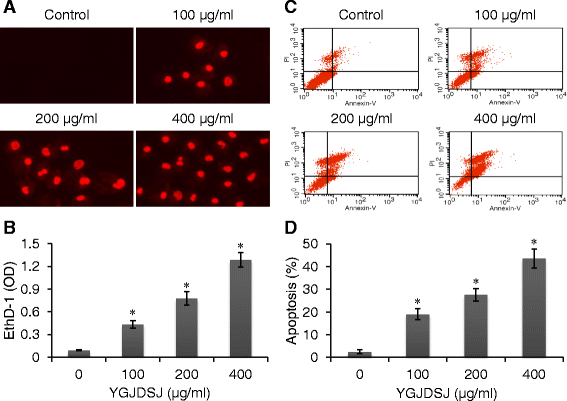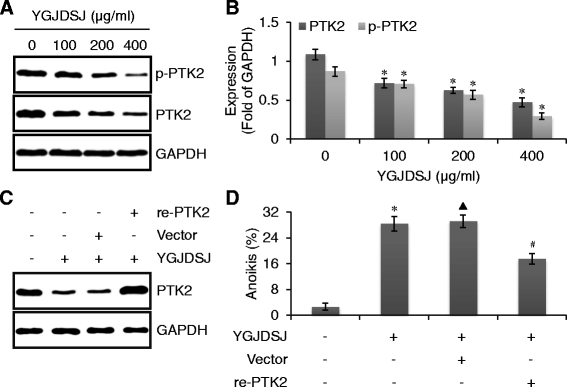Herbal formula YGJDSJ inhibits anchorage-independent growth and induces anoikis in hepatocellular carcinoma Bel-7402 cells
- PMID: 29338725
- PMCID: PMC5771203
- DOI: 10.1186/s12906-018-2083-2
Herbal formula YGJDSJ inhibits anchorage-independent growth and induces anoikis in hepatocellular carcinoma Bel-7402 cells
Abstract
Background: Based on clinical medications and related studies, we established a Yang-Gan Jie-Du Sang-Jie (YGJDSJ) herbal formula for hepatocarcinoma treatment. In present study, we evaluated the anti-cancer potential of YGJDSJ on suspension-grown human hepatocellular carcinoma Bel-7402 cells.
Methods: Bel-7402 cells were cultured in poly(2-hydroxyethyl methacrylate) (poly-HEMA) coated plates and treated with YGJDSJ. Anchorage-independent cell growth was detected by cell Counting Kit-8 (CCK-8) assay and soft agar colony formation assay. Anoikis was detected by ethdium homodimer-1 (EthD-1) staining and flow cytometry analysis. Caspases activities were detected by the cleavage of chromogenic substrate. Reactive oxygen species (ROS) was detected by 2',7'-dichlorofluorescin diacetate (DCFH-DA) staining. Protein expression and phosphorylation was identified by western blot. Protein expression was knocked-down by siRNA.
Results: YGJDSJ inhibited the proliferation of Bel-7402 cells in poly-HEMA coated plates and anchorage-independent growth of Bel-7402 cells in soft agar. YGJDSJ also induced anoikis in Bel-7402 cells as indicated by EthD-1 staining and flow cytometry analysis. YGJDSJ activated caspase-3, - 8, and - 9 in suspension-grown Bel-7402 cells. The pan-caspase inhibitor Z-VAD-FMK significantly abrogated the effects of YGJDSJ on anoikis in suspension-grown Bel-7402 cells. In addition, YGJDSJ increased ROS in suspension-grown Bel-7402 cells. The ROS scavenger N-acetyl-L-cysteine (NAC) partially attenuated YGJDSJ-induced activation of caspase-3, - 8 and - 9 and anoikis in suspension-grown Bel-7402 cells. Furthermore, YGJDSJ inhibited expression and phosphorylation of protein tyrosine kinase 2 (PTK2) in suspension-grown Bel-7402 cells. Over-expression of PTK2 significantly abrogated YGJDSJ induced anoikis.
Conclusions: YGJDSJ inhibits anchorage-independent growth and induce caspase-mediated anoikis in Bel-7402 cells, and may relate to ROS generation and PTK2 downregulation.
Keywords: Anoikis; Caspases; Chinese herb; Hepatocellular carcinoma; Protein tyrosine kinase 2; Reactive oxygen species.
Conflict of interest statement
Ethics approval and consent to participate
Not applicable.
Consent for publication
Not applicable.
Competing interests
The authors declare that they have no competing interests.
Publisher’s Note
Springer Nature remains neutral with regard to jurisdictional claims in published maps and institutional affiliations.
Figures





Similar articles
-
Traditional Chinese medicine formulation Yanggan Jiedu Sanjie inhibits TGF-β1-induced epithelial-mesenchymal transition and metastatic potential in human hepatocarcinoma Bel-7402 cells.BMC Complement Altern Med. 2019 Mar 15;19(1):67. doi: 10.1186/s12906-019-2477-9. BMC Complement Altern Med. 2019. PMID: 30876428 Free PMC article.
-
Effect of Yanggan Jiedu Sanjie formula on human hepatocellular carcinoma Bel-7402 cells.J Tradit Chin Med. 2019 Feb;39(1):26-33. J Tradit Chin Med. 2019. PMID: 32186020
-
Modified Yi Guan Jian, a Chinese herbal formula, induces anoikis in Bel-7402 human hepatocarcinoma cells in vitro.Oncol Rep. 2011 Dec;26(6):1465-70. doi: 10.3892/or.2011.1414. Epub 2011 Aug 5. Oncol Rep. 2011. PMID: 21822542
-
Polygonum cuspidatum Extract Induces Anoikis in Hepatocarcinoma Cells Associated with Generation of Reactive Oxygen Species and Downregulation of Focal Adhesion Kinase.Evid Based Complement Alternat Med. 2012;2012:607675. doi: 10.1155/2012/607675. Epub 2012 Sep 13. Evid Based Complement Alternat Med. 2012. PMID: 23008742 Free PMC article.
-
Roles of anoikis in hepatocellular carcinoma: mechanisms and therapeutic potential.Med Oncol. 2025 Jan 30;42(3):58. doi: 10.1007/s12032-025-02612-9. Med Oncol. 2025. PMID: 39885089 Review.
Cited by
-
Mechanisms for Modulating Anoikis Resistance in Cancer and the Relevance of Metabolic Reprogramming.Front Oncol. 2021 Mar 29;11:626577. doi: 10.3389/fonc.2021.626577. eCollection 2021. Front Oncol. 2021. PMID: 33854965 Free PMC article. Review.
-
MicroRNA-133b/EGFR axis regulates esophageal squamous cell carcinoma metastases by suppressing anoikis resistance and anchorage-independent growth.Cancer Cell Int. 2018 Nov 22;18:193. doi: 10.1186/s12935-018-0684-y. eCollection 2018. Cancer Cell Int. 2018. PMID: 30479571 Free PMC article.
-
Traditional Chinese medicine formulation Yanggan Jiedu Sanjie inhibits TGF-β1-induced epithelial-mesenchymal transition and metastatic potential in human hepatocarcinoma Bel-7402 cells.BMC Complement Altern Med. 2019 Mar 15;19(1):67. doi: 10.1186/s12906-019-2477-9. BMC Complement Altern Med. 2019. PMID: 30876428 Free PMC article.
-
Regulation of pancreatic cancer metastasis through the Gli2-YAP1 axis via regulation of anoikis.Genes Dis. 2022 May 24;9(6):1427-1430. doi: 10.1016/j.gendis.2022.05.010. eCollection 2022 Nov. Genes Dis. 2022. PMID: 36157479 Free PMC article. No abstract available.
-
Uncovering the Anticancer Mechanisms of Chinese Herbal Medicine Formulas: Therapeutic Alternatives for Liver Cancer.Front Pharmacol. 2020 Mar 18;11:293. doi: 10.3389/fphar.2020.00293. eCollection 2020. Front Pharmacol. 2020. PMID: 32256363 Free PMC article. Review.
References
-
- Yüksel Ş, Boylu Akyerli C, Cengiz Yakıcıer M. Angiogenesis, invasion, and metastasis characteristics of hepatocellular carcinoma. J Gastrointest Cancer. 2017; 10.1007/s12029-017-9962-5. - PubMed
MeSH terms
Substances
Grants and funding
LinkOut - more resources
Full Text Sources
Other Literature Sources
Medical
Research Materials
Miscellaneous

